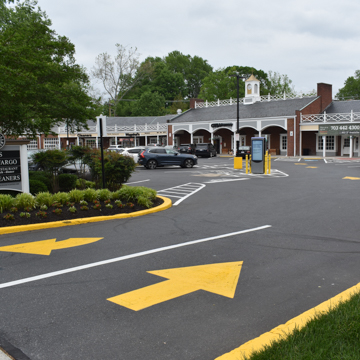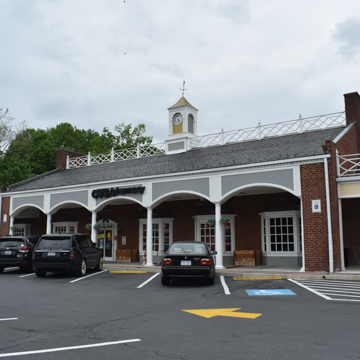Located in the suburban Spring Valley neighborhood near Tenleytown, the Spring Valley Shopping Center is a historic commercial block, made up of six connected buildings. It was developed by the firm W.C. and A.N. Miller between 1939 and 1950 to serve the adjoining wealthy neighborhoods of Wesley Heights and Spring Valley. The development is unique because the entryway curves off of Massachusetts Avenue and the site was managed by a single real estate firm.
Architectural historian Richard Longstreth has shown that department stores of the first half of the twentieth century expanded their reach by operating suburban branches and catering to a more remote and dispersed audience. Indeed, the building type helped to redefine the city as a region rather than a concentrated downtown area. In addition to shaping the physical environments around them, department stores also created gendered space and defined their relation to consumerism. And as downtowns declined significantly in the post–World War II era, department stores in the urban periphery became especially central to everyday civic and social life.
When developing Spring Valley, the Miller firm studied other well-known suburban subdivisions in the nation, including Shaker Heights in Cleveland, the Country Club District in Kansas City, and Roland Park in Baltimore. The Park and Shop on Connecticut Avenue in Cleveland Park, Northwest Washington, was also influential. Especially significant as well was the restoration of Colonial Williamsburg, which served as inspiration for the overall Colonial Revival aesthetic. Like the drive-in markets in Los Angeles, which it was also inspired by, the L-shaped building faced a large forecourt with off-street parking and consisted of interconnected stores.
The first store in the development was Garfinckel’s, built of brick in 1942 as an early example of a major department store branch constructed in the outlying area. The owners sought to reach the many potential customers who aimed to conserve gasoline and time amid World War II. Designed by Gordon McNeil, the structure included Colonial Revival features such as hipped roofs, large corner chimneys, and details like columns and the Newport-style cupola. The interior fixtures and furniture were designed by the New York firm of William and Harrell. Advertisements for Garfinckel’s noted the artistic qualities of the interior, including the color scheme, spacious floors, comfortable and tasteful furniture, and opportunities for people-watching. McNeil’s design illustrated that commercial architecture could suggest the quality of the merchandise sold on the interior.
The remaining structures were connected with partition walls and were designed to match Garfinckel’s. The first two were completed in 1947 and the last building was erected around 1950; the latter was two-and-one-half stories in height and was occupied by the Metropolitan Bank of Washington and the furniture store Mayer and Company. The designs paid particular attention to the building rears and integrating compatible materials and style, in anticipation of future residential development. Also central to the development was parking, which was positioned prominently for convenience and privileging of a suburban mode of shopping.
The commercial development thrived for several decades. However, with the completion of nearby suburban shopping malls in the 1980s, it experienced declining sales. In 1990, Garfinckel’s closed. It took an additional five years to clean the site of leaked fuel from the gas station and to complete major renovations. In 1993, Spring Valley residents also discovered 140 unexploded mortar and artillery shells in the neighborhood—remnants from the Army's use of the area as a test site for chemical weapons and other munitions during World War I. Extensive environmental remediation further contributed to the increased desirability of the area for residential and commercial real estate.
References
Howard,Vicki. From Main Street to Mall: The Rise and Fall of the American Department Store. Philadelphia: University of Pennsylvania Press, 2015.
Lee, Antoinette, "Square 1500," Washington, D.C. National Register of Historic Places Inventory-Nomination Form, 2003. National Park Service, U.S. Department of the Interior, Washington, D.C.
Longstreth, Richard W. The American Department Store Transformed, 1920-1960. New Haven: Yale University Press, 2010.
Moore, Kate. "Milestones, Memories in Spring Valley: In DC, the Greening of a Neighborhood." Washington Post, December 17, 1994.
Tangires, Helen. Movable Markets: Food Wholesaling in the Twentieth-Century City. Baltimore: Johns Hopkins University Press, 2019.

















